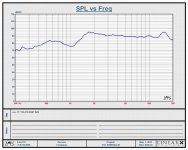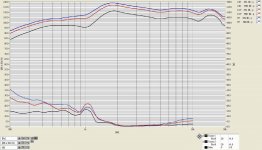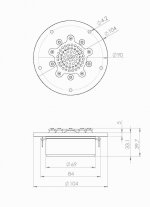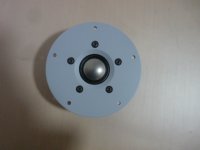The rule of thumb is to cross the tweeter at least one octave above its resonance frequency.
However, you also need to consider the performance of the driver you are crossing over with. That performance criteria includes things like the other driver's frequency response, cone breakup characteristics, impedance curve, and driver directivity.
The directivity, for instance, should match the directivity of the the tweeter at the crossover frequency.
So, the whole process is much more complex than simply measuring the performance parameters of a tweeter - you need to consider the rest of the system and the driver(s) it interfaces with.
However, you also need to consider the performance of the driver you are crossing over with. That performance criteria includes things like the other driver's frequency response, cone breakup characteristics, impedance curve, and driver directivity.
The directivity, for instance, should match the directivity of the the tweeter at the crossover frequency.
So, the whole process is much more complex than simply measuring the performance parameters of a tweeter - you need to consider the rest of the system and the driver(s) it interfaces with.
What is the make/model of the tweeter? from the impedance curve it looks like it is a vented design..... I've not come accross one of those before. If it is a vented design then it looks like the tuning frequency is somewhere between 800 and 1000 Hz. You would definitely want to cross at least an octave higher than that (as Loren42 said) and probably with a steep crossover. Any bass reflex speaker unloads below resonance, so it would be very ugly with this tweeter (if indeed it is vented) if it were receiving any significant power below resonance.
Tony.
Tony.
The below is the THD test data measured by my friend, maybe the distance and baffle is different, so it is very different between the two equipments. but i think the THD data (1w,5w,10w) can be use for reference for xover design. Please give your suggestion, thanks!
sorry for the poor English.
View attachment 349012
No. That information alone is not enough to make a determination as I stated in my previous post.
Just applying the rule of thumb I stated and if your impedance curves are correct, leads to a crossover frequency of no less than 3,200 Hz. Other factors still apply.
What is the make/model of the tweeter? from the impedance curve it looks like it is a vented design..... I've not come accross one of those before. If it is a vented design then it looks like the tuning frequency is somewhere between 800 and 1000 Hz. You would definitely want to cross at least an octave higher than that (as Loren42 said) and probably with a steep crossover. Any bass reflex speaker unloads below resonance, so it would be very ugly with this tweeter (if indeed it is vented) if it were receiving any significant power below resonance.
Tony.
You are right.
It looks like the impedance curve is not the driver in free air, but a ported cabinet.
You need to characterize the driver in free air.
The rule of thumb is to cross the tweeter at least one octave above its resonance frequency.
However, you also need to consider the performance of the driver you are crossing over with. That performance criteria includes things like the other driver's frequency response, cone breakup characteristics, impedance curve, and driver directivity.
The directivity, for instance, should match the directivity of the the tweeter at the crossover frequency.
So, the whole process is much more complex than simply measuring the performance parameters of a tweeter - you need to consider the rest of the system and the driver(s) it interfaces with.
Thanks! yes, your reply is very professional, I mean if the woofer's performance is not good above 1.6kHz, this tweeter whether can be set the xover point at 1.6kHz, in other words, How is the tweeter's performance if the xover point at 1.6kHz? I only want to use for onwall speaker system, the system power(RMS) is about 50w.
Thanks! yes, your reply is very professional, I mean if the woofer's performance is not good above 1.6kHz, this tweeter whether can be set the xover point at 1.6kHz, in other words, How is the tweeter's performance if the xover point at 1.6kHz? I only want to use for onwall speaker system, the system power(RMS) is about 50w.
Please provide the make and model of the tweeter (and woofer if possible) and we can give you an idea of what to expect.
Is the db scale on the distortion measurements correct? If the THD plot is really 100DB down (at 2Khz) then this would be an incredibly low distortion tweeter! Even where the spike is around 1Khz is 70db down, which would equate to 0.03% distortion!!
You could generalize and say that there is a distortion peak around 1.1Khz and that distortion is virtually non existant from 2Khz and make a decision to cross over at no lower than 2Khz if low distortion is a high priority on the design criterea.
One thing you have to remember is that the crossover is not a brick wall filter (ie it doesn't just stop producing any sound below the crossover frequency) the speaker rolls off at so many db / octave depending on the filter order. So even if you crossover at 2Khz, the speaker will still be making some contribution at 1Khz. If you use 4th order it will be 24db down at 1Khz with a 2Khz crossover point.
Tony.
You could generalize and say that there is a distortion peak around 1.1Khz and that distortion is virtually non existant from 2Khz and make a decision to cross over at no lower than 2Khz if low distortion is a high priority on the design criterea.
One thing you have to remember is that the crossover is not a brick wall filter (ie it doesn't just stop producing any sound below the crossover frequency) the speaker rolls off at so many db / octave depending on the filter order. So even if you crossover at 2Khz, the speaker will still be making some contribution at 1Khz. If you use 4th order it will be 24db down at 1Khz with a 2Khz crossover point.
Tony.
How is the tweeter's performance if the xover point at 1.6kHz?
Is your tweeter a horn loaded compression driver? It would help greatly if you can provide the make and model of tweeter and woofer. The selection of a crossover frequency is meaningless unless the system is taken as a whole.
You are right.
It looks like the impedance curve is not the driver in free air, but a ported cabinet.
You need to characterize the driver in free air.
Hi Loren42,
This impedance curve is measured in free air, not mounted on cabinet.
Is your tweeter a horn loaded compression driver? It would help greatly if you can provide the make and model of tweeter and woofer. The selection of a crossover frequency is meaningless unless the system is taken as a whole.
The tweeter is a dome, the diaphragm is titanium, not horn loaded.
Attachments
Is the db scale on the distortion measurements correct? If the THD plot is really 100DB down (at 2Khz) then this would be an incredibly low distortion tweeter! Even where the spike is around 1Khz is 70db down, which would equate to 0.03% distortion!!
You could generalize and say that there is a distortion peak around 1.1Khz and that distortion is virtually non existant from 2Khz and make a decision to cross over at no lower than 2Khz if low distortion is a high priority on the design criterea.
One thing you have to remember is that the crossover is not a brick wall filter (ie it doesn't just stop producing any sound below the crossover frequency) the speaker rolls off at so many db / octave depending on the filter order. So even if you crossover at 2Khz, the speaker will still be making some contribution at 1Khz. If you use 4th order it will be 24db dwn at 1Khz with a 2Khz crossover point.
Tony.
The distortion scale is %.
The tweeter is a dome, the diaphragm is titanium, not horn loaded.
I must admit I'm at a loss. I've never seen a dome tweeter with two impedance peaks. Usually, the resonance frequency is only one peak. Two peaks are observed in compression drivers.
Yes, it is really two impedance peak, it is different than tranditional tweeter, but seems very popular.
View attachment 349037
Could be measurement error. Who makes it and what is the model number?
I don' think it is measurement error, since other tweeter is one peak, and the free air impedance is easy to operate by LMS.Could be measurement error. Who makes it and what is the model number?
Assuming the impedance sweep is correct, the impedance peak at about 1,700Hz is the one that determines the lowest crossover frq. I would probably try at between 2,500Hz to 3,000Hz for a start, and that is with a LCR in place. 3,500Hz is a safe bet but 1.6kHz is asking a lot. You can see from your SPL plot that 1.6kHz is on the down slope. Basically, that's where the tweeter is dying off. You'll be crossing right at the limit of the tweeter. Can be done but I'm not a man of extremes.
On the looks of it, this is a substantial tweeter with an air chamber, so it should be able to go low. Does the manufacturer publish measurements and do you have a link?
- Status
- Not open for further replies.
- Home
- Loudspeakers
- Multi-Way
- The crossover point for the new tweeter




